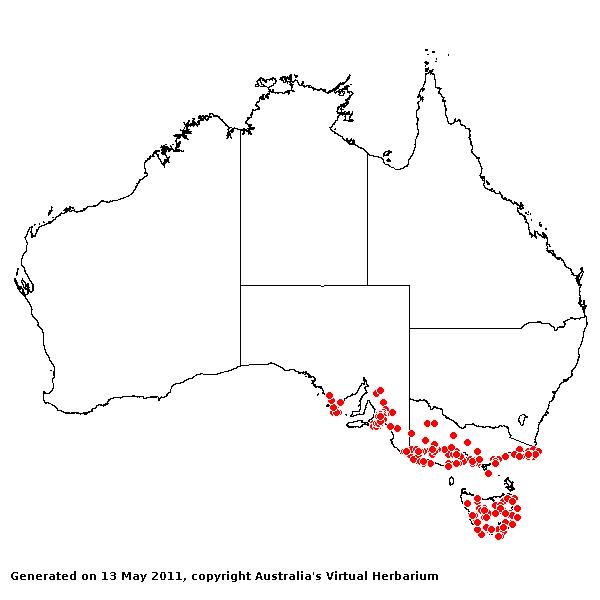Poa clelandii Vickery. Contr.
New South Wales Natl Herb. 4: 193 (1970).
Classification.
(GPWG 2001) : Subfamily Pooideae. Tribe Poeae.
Type of Basionym or
Protologue Information: Australia: South Australia: National Park (near
Adelaide): 17 Dec 1949, J.B. Cleland (HT: AD 95626093).
Key references
(books and floras): [2002] D.Sharp & B.K.Simon, AusGrass, Grasses of
Australia, [2006] J.Jessop, G.R.M.Dashorst, F.M.James, Grasses of South
Australia (146), [2009] A.Wilson (ed.). Flora of Australia, Vol 44A.
Poaceae 2 (326).
Illustrations:
[2006] J.Jessop, G.R.M.Dashorst, F.M.James, Grasses of South Australia (147, fig. 98), [2009]. A.Wilson (ed.),
Flora of Australia 44A: Poaceae 2 (323, Fig. 43).
Habit.
Perennial. Rhizomes absent or present, short. Culms stature slender to
delicate, 5–75 cm tall, 3–4 -noded. Mid-culm internodes glabrous or pubescent.
Lateral branches simple. Leaves mostly basal. Leaf-sheaths smooth or
scaberulous, glabrous on surface. Ligule an eciliate membrane, 0.25–1.75 mm
long, abaxially hairy, truncate or obtuse. Leaf-blades erect, flat or
conduplicate, 7.5–19.5(–25) cm long, 1–5 mm wide. Leaf-blade surface smooth or
scaberulous or scabrous, glabrous.
Inflorescence.
Inflorescence compound, a panicle. Panicle lanceolate, 9–20 cm long.
Spikelets.
Spikelets pedicelled. Fertile spikelets many flowered, with at least 2 fertile
florets (2–5), comprising 2–5 fertile floret(s), with diminished florets at the
apex, oblong, laterally compressed, 4–6 mm long.
Glumes. Glumes
similar. Lower glume oblong, membranous, keeled, 1-keeled, 3 -nerved. Upper
glume oblong, 1.5–2.8 mm long, membranous, keeled, 1-keeled, 3 -nerved.
Florets.
Fertile lemma (1.75–)3.2–3.4 mm long, keeled, 5 -nerved. Lemma surface
indumented. Lodicules present. Anthers 3. Grain 1.5 mm long.
Continental
Distribution: Australasia.
Australian
Distribution: South Australia, Victoria, Tasmania.
South Australia:
Eyre Peninsula, Northern Lofty, Murray, Yorke Peninsula, Southern Lofty,
South-eastern. Victoria: East Gippsland, Gippsland Plain, Grampians,
Midlands, Otway Plain, Wilsons Promontory, Wannon. Tasmania: North East,
West Coast, Central Highlands, Midlands, East Coast, South West.
Notes.
Distinguished by the glabrous honey-coloured ligule, usually compressed culm,
broad, keeled, abruptly pointed leaf apex and purple colouration.
Endemic. Commonly in
moist sites such as sandy swamplands and wet heathlands at low altitudes, also
in rocky sites at higher altitudes in the Grampians, Vic. and Central Highlands
of Tas. Flowers Sept.-Jan.(-Apr.). Fruits Dec.-Feb.(-Apr.).



